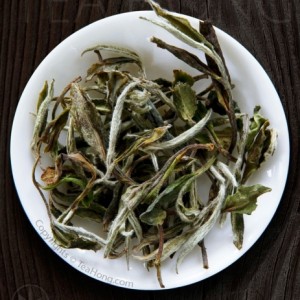Fuding Semi-black: White Tea with a Twist

In terms of leaf colour, Semi-black White is very close to Oriental Beauty with the blacks, yellows, browns, and whites, but that’s where the similarity ends. This is a tea worth its own recognition for its individualistic gastronomic character.
We have the problem of defining this particular variety, and not quite sure if we should call it a white tea or a black tea, because it is a little bit of both. There is no definite name for it as well — different producers call it by different names.
a new tea difficult to name
This is a new tea variety produced by combining the processing methods of White Peony and gongfu black tea, though the rolling and “fermentation” is much reduced. One producer who makes this refers to it using the name of a mass market white tea, the so-called “New Technique White Tea” 新工藝白茶, which is basically a machine processed and harsher tasting version of White Peony, otherwise known as Sau Mei, the popular dimsum restaurant tea.
But it is not that. For one thing, it is a lot more expensive because of the pluck quality and labour that are required. It tastes a lot finer.
One calls it Baihao Oolong 白毫烏龍, which is known also as White Hair Oolong, Bingfeng Oolong, Champagne Oolong, Oriental Beauty, Dongfang Meiren etc, the famous Taiwan export that once was appointed by the British monarch in late 19th century. But it is not that either, although by the manner of fermentation processing, they are very similar. The Taiwan version, basically not an oolong in the true tea definition, is more like a black tea, although not totally. The tea cultivar is very different.
We have to properly name a tea that is produced basing on the white tea process, with added “rolling” ( wringing, twisting are more accurate concepts ) and extended oxidation like in an Oriental Beauty, but made from the cultivar Fuding Daibai, the same that is used for White Peony and Silver Needles. “Fuding Semi-Black White” 福鼎紅白茶 reflects its tea definition nature, though perhaps not very creative; but let’s leave the remaining work to marketing people.
Nevertheless, we like this tea quite well and would like to present it to you here.
tasting

The colour on the leaves indicates a much deeper oxidation than white tea, more even than oolongs, and some leaves as deep as a black tea.
Fuding Semi-Black White has all the taste characters of Fuding White Peony in addition to the fruity aroma and floral sweetness of a Bailin Gongfu Black, although not as prominent. This renders a lot more body and taste dynamic, rather like a cocktail.
I’d say it is light and lively like a white peony, smooth and quite round, and fruity and floral like a Minhong Gongfu, though not so full body, deep and substantial. It should serve well as a casual and daily tea.
The tea is flexible like other white teas, and can be infused well at around 90°C.
origin
A few years ago, I had got so fed-up with Fuding White Peony ever getting lighter and lighter in fermentation that I began preaching to the producers that they were losing a tradition to the superficiality of the easy sell to novice tea drinkers the look of a greener tea. They were basically burning their own bridges.
- Tianshan Yinya 天山銀芽 a rare green tea from the Taimushan-Tianshan region in Eastern Fujian. 20554 | 8833
- Jasmine Silver Pearls, aka Honey Pearl Pekoe, Moli Xiao Longzhu 茉莉小龍珠, is a premium scented green tea. This one is a premium quality from Fujian
- White Peony aka Bai Mudan 白牡丹, This authentic white tea is from Fuding and made in the local style using the Fuding Dabai cultivar, special grade, matured for 1 year. 20197 | 8730
- Semi-black White 加揉白牡丹 from Fuding Fujian, as inspired by Taiwan’s “Dongfang Meiren”
- Bailin Gongfu: To the east of Zhenghe where Bai Mudan is made with the cultivar Fuding Dai’bai, a counterpart of Zhenghe Dai’bai, Bailin Gongfu is made. The taste is a little more floral, but shorter, and the body not as round. The appearance can be rather similar. This particular selection in the photo is a special grade 3, one step above grade 1. Notice the typical large and unwieldy tips.
A couple of years went by and the daughter of a producer told me she had a special tea to show me, while filling a gaiwan with what I thought was White Peony. The father came in later and told me how the processing of this delightful tea was inspired by the Taiwan counterpart. He kept referring it to the Taiwan name, feeling quite proud.
Clearly the initial withering is done much as a White Peony, but towards the end before the leaves are piled, they are given a round of slight rolling for the twist. Fermentation is thus initiated by the broken cells, albeit for a very short time, to avoid destroying the characters of the original white tea.
Now a small number of people are making this in Fuding using the cultivar Fuding Daibai. The plant and their white tea processing framework render the uniqueness of this tea from the muse originated from Taiwan.















